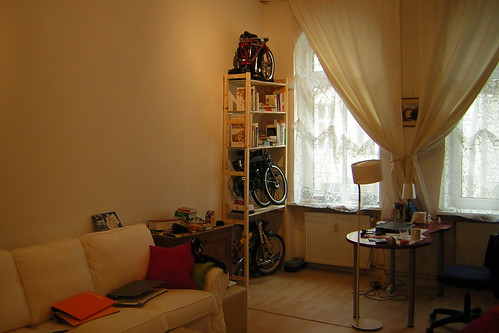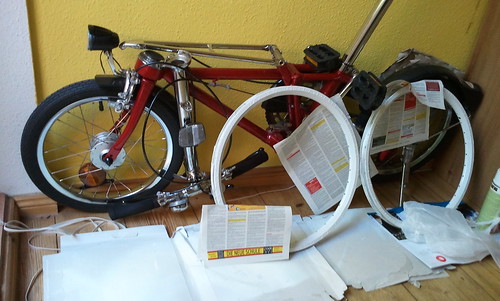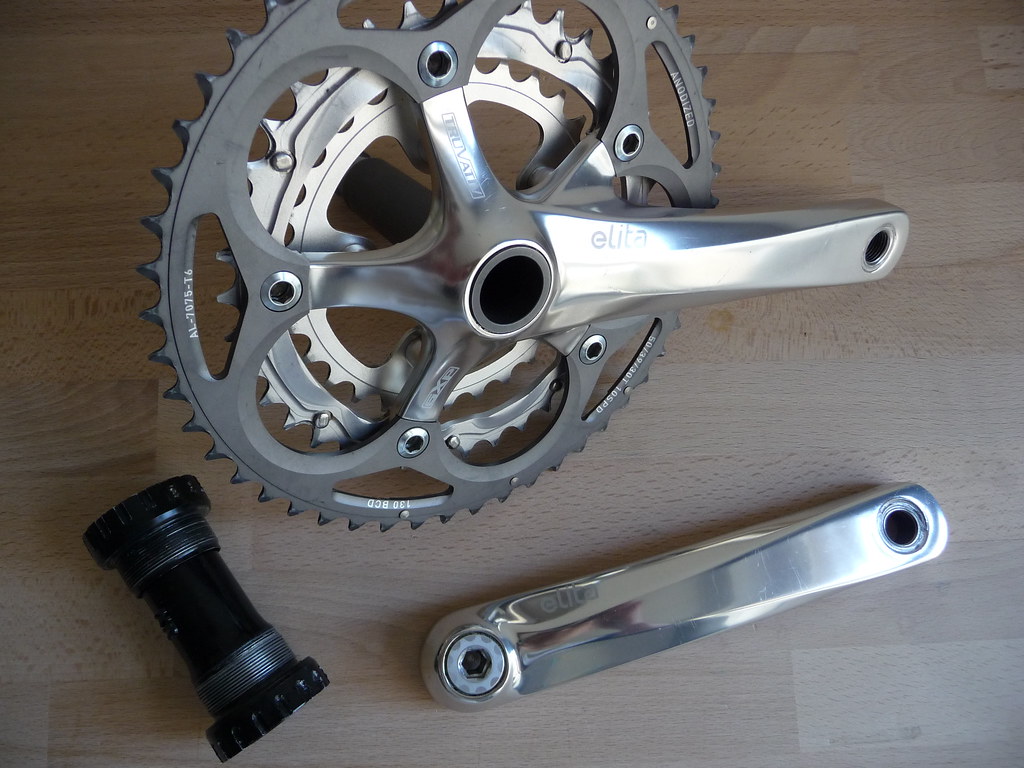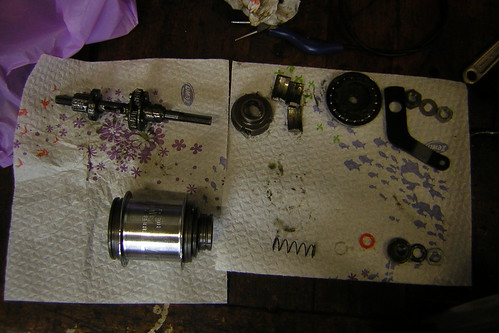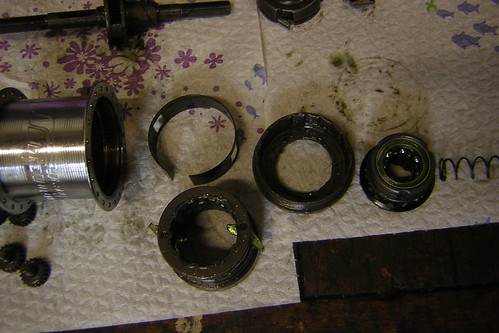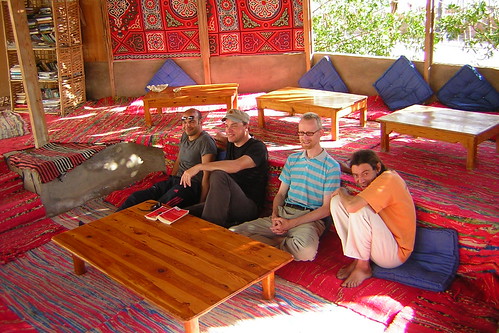Fascinated by bicycle hub gears and the vision that this type of gears not only works as part of the hub, but also as part of the chainwheel (for example), I have started to study the subject more deeply. Wikipedia doesn't offer much on the subject. Amazon Germany had a book devoted to epicyclic gears (also known as planetary gears), but it covered mostly aspects that I don't need to understand bicycle gears. Finally I discovered some patents on the subject (all available for free online!) and as I am learning more and more about the subject, I will explain it here in simple terms and with close relation to cycling practice. So here's the first part of what I hope to become a comprehensive and exciting series: the planet of the gears.
In this first part I want to deal with one simple question: what is the transmission ratio of the simplest planetary gear set used in bicycles? The entire complexity of planetary gears (and we'll get to pretty complex arrangements in later posts) can be derived from two formulas which I'll show you after explaining the general setting and the terminology (which I call nomenclatura because I like that word). First of all, I follow the literature by reserving the word “gear” for the cog wheels, that is, physical parts of the gear system. The different settings for transmission ratios which in ordinary English are called first gear, second gear, and so on, will be called first speed, second speed, and so on, so we don't confuse them with the parts of our gearbox.
Now, to the Input and Output parts of a simple planetary gear system. There are three shafts which can be used to transmit a force: the sun gear
s, the ring gear
r, and the carrier
c of the planet gears. If all three are used, the gearing adds two inputs to generate an output or vice versa. To use the gearing as a transmission to translate rotational velocities, one of the three possible shafts will be fixed. If we'd fix the planet carrier, then the planets wouldn't revolve around the sun any more and we had a pretty boring non-planetary transmission. There might be reasons to do this in a practical setting (because it could yield an additional speed), but for the calculation of planetary transmission ratios, we do not need to consider it. We'll either fix the ring gear or the sun gear.
Nomenclatura: Big letters S, P, R denote the number of teeth of the sun gear, planet gears, and ring gear respectively. (The planet carrier itself does not have any teeth.)
Small letters
s,
c,
p,
r denote the rotational velocities of those gears and the carrier.
Formula of stationary gears: For two spur gears (that is plain, ordinary cog wheels) with teeth numbers Y and Z and rotational velocities y and z which are engaged, the ratio of rotational speeds is the inverse of the ratio of number of teeth, that is, y/z = Z/Y, or y×Y = z×Z. If one of the gears is a ring gear, a minus has to be thrown into the formula like that: -r×R = z×Z.
Stationary transmission ratio: The weird thing about planetary gears is that gears are not just turning around their shafts but the shafts themselves are moving in space. In order to calculate the transmission ratios of planetary gears, we will first assume that those little planets are not actually moving. We will imagine that we –as the observer– are sitting on the planet carrier and from our relative position the planets do not move (but they still rotate). The transmission ratios observed from this viewpoint are called the stationary transmission ratios.
More Nomenclatura: Superscript x^y denotes rotational speed of shaft x when observed while sitting on shaft y. (This will be an actual superscript as soon as I have found a volunteer who'll edit my blog.)
Formula of translation: z^y = z^x - y^x
Let me explain this formula with a picture: imagine X sits on the curb of a street, y sits on the shoulder of somebody who's walking by towards North, and z sits on the shoulder of a cyclist, also going North. From y's point of view, x is moving southwards and z is moving northwards (assumed it's faster than y) with a speed just slower than seen from x.
As a corollary y^y = y^x - y^x = 0.
Let's apply the formulae: in the stationary case, we observe every velocity from the planet carrier, thus all velocity variables get superscripted with c. The sun gear engages with the planets, thus: s^c×S = p^c×P. And the ring gear engages with the planets, thus -r^c×R = p^c×P. Since we are not interested in the rotational speeds of the planets themselves, we can fuse the two equations to get s^c×S = -r^c×R. Additionally we know c^c = 0.
Now let's look at the case of a fixed sun gear. We want to translate all values x from x^c to x^s, thus we apply x^s = x^c - s^c. Since ring gear and planet carrier are our in- and output, we want to derive the ratio r^s/c^s which equals (r^c - s^c)/(c^c - s^c).
Now we fill in what we know from the stationary case, namely c^c = 0 and r^c = - s^c × S/R.
Thus r^s/c^s = (- s^c × S/R - s^c) / ( - s^c ) = S/R + 1.
I hope that even if you got lost a little in the middle, you'll appreciate the simplicity of the result gear_ratio = r^s/c^s = S/R + 1 which we derived from the simple axioms y×Y = z×Z and z^y = z^x - y^x.
Taking the coarse bounds 0 < S < R, we find that we can use this simple planetary layout to get a ratio 1 < δ(r, c) < 2, that is at most double or half the speed. (How close we can get to 1, that is, what the smallest possible gear step is, depends on some further mechanical parameters.) In the next post we will see, how different usages of this simple gear can be used to build a two-speed gearing (as does the Schlumpf speed-drive) and even a three-speed gearing (as do the three-speed hubs from F&S and Sturmey Archer invented a hundred years ago).
Now the case of a fixed ring gear
s^r = s^c - r^c = s^c + s^c*S/R
c^r = 0 - r^c = + s^c*S/R
δ(s, c) = s^r / c^r = (1 + S/R) / S/R = R/S + 1
rough bounds 0 < S < R
so 2 < δ(s, c) < ∞
Now it is theoretically interesting that we can make gears with ratios from 1 to 2 and from 2 to ∞ and thereby cover the entire possible range (with a small gap at 2, meaning we can't have a transmission ratio of exactly or close to 2).
A ratio of more than double is usually impractical for a single gear step, but this arrangement can be used well in combination with the other one. A simple example is Schlumpf's Mountain Drive which is designed to work in combination with a rear derailer. Since the planetary gear's ratio is so big, the arrangement will spread the available gears further out and avoid gear overlap, that is, more effective gears with less logical gears to shift. We will later see, how two planetary stages can be combined to create a staged gear arrangements whose gears can be shifted in a single sequence with a single shifter and no overlap.
Here are some interesting things to cover in the future:
- How are multiple gears actually switched?
- How do the traditional 3, 5, and 7 gear hubs work?
- How do the newer 4, 8, 11, and 14 gear hubs work?
- What other improvements can be made to a simple gear box: shifting under load, saving weight, increasing reliability, and much more!
